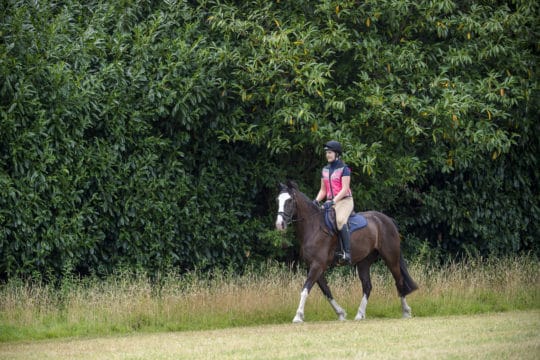Is interval training just for pros, or a useful tool for getting your own horse fit, too? Fizz Marshall breaks it down and explains how you can integrate it into your riding regime

Fitness work is a key component of any horse’s weekly exercise routine. Regardless of your chosen discipline, having your horse fit enough to do his job is really important in preventing injury and maintaining his longevity. Of course all exercise, be it hacking, schooling or lungeing, will contribute to your horse’s overall fitness, but exercise specifically targeting his athletic conditioning will improve his stamina, agility and how well he recovers from cardiovascular effort.
Top tip If your horse is coming back into work after time off, follow your regular early fitness programme until he’s started canter work before introducing interval training.
The principles of interval training
Interval training (IT) is widely used for improving athletic performance in both sport and racehorses. IT challenges and conditions a horse’s cardiovascular system by requiring him to complete bouts of high-intensity exercise followed by a short recovery period in which his heart rate returns to just above resting.
The beauty of IT is that it can be done anywhere – on gallops, around the edge of a field, on a suitable bridleway or even in a large, 40x60m arena. As would be the case for any canter work you do, be mindful of the conditions underfoot and the impact on your horse’s legs. Deep, muddy ground has the potential to be just as damaging as hard or rutted going, so look for sound footing with some give, be that a synthetic surface or a natural one.
Top tips
It’s important to keep track of how long you’ve been working your horse, both in each segment and overall. Therefore a stopwatch, or wristwatch with a timer on it, is essential in order to stick to your programme.
Incorporating hills into your IT will increase its intensity and thus improve the fitness benefits for your horse. Cantering uphill will also help to reduce concussion on your horse’s front legs.
The research
Essentially, the aim of a conditioning programme such as IT is to improve your horse’s anaerobic threshold by training his system to work aerobically for as long as possible. The anaerobic threshold is the highest exercise intensity that your horse can sustain for a prolonged period without substantial lactic acid build-up. This means that, by using IT to push the limit of this threshold, your horse will be able to keep exercising for longer before he reaches the point of fatigue.
Scientific research has shown IT to be more effective for conditioning your horse’s aerobic system than ‘continuous’ work without rest breaks. Conducted over a period of six weeks, a study by scientists at Washington State University’s College of Veterinary Medicine found that IT resulted in reduced bodyweight compared to the continuous group and that it took fewer gallop strides to complete than continuous training. This showed that IT gives you more for less – reduced strain on your horse’s body with better results.
Did you know? Aerobic exercise, where oxygen is carried to the muscles to energise them, is generally low-to-medium effort and relatively easy to sustain – trotting, for example. Anaerobic exercise is fuelled by glycogen and fat rather than oxygen, and builds up lactic acid. This occurs in short bursts of high-intensity exercise.
Top tip
Before you get started with any IT session it’s important to allow your horse sufficient time to warm up. Hacking to the gallops or field where you plan to do your work is a good way of doing this. If you’re completing your training in a large arena, go for a short stroll first to allow your horse to loosen off.
Have a heart
Knowing your horse’s resting heart and respiratory rates will reveal how hard he’s working. If you want to track his heart rate during exercise it’s worth investing in a monitor, which are available to buy online.
Checking his resting heart rate can be done with a stethoscope placed where his girth would sit, just lower than his elbow on the left-hand side of his body. Otherwise, place your index and middle finger under his jawline below the muscles of his cheek to find the mandibular artery. Once you find his pulse, count for 10 seconds and then times that number by six to calculate beats per minute (bpm). The normal resting heart rate for a horse is around 30-44 bpm.
Breathe easy
Your horse’s resting respiratory rate is around 8-16 breaths per minute. Measuring this can be an easier way to assess his recovery in between high intensity intervals than heart rate if you’re not using a digital monitor, because you can count his breaths while in the saddle.
As flight animals, horses naturally enter an initial recovery phase very quickly after finishing strenuous exercise. This means that as soon as you allow him to walk in between bouts of canter during an IT session, his heart rate will drop relatively quickly. Keeping an eye on heart or breathing rates will let you know when he’s at this steady state before your next canter, and is therefore useful for tracking his progress and making sure you’re not doing too much too soon.
Top tip
As is the case for any type of canter work, shortening your stirrups will help you get up off your horse’s back, allowing him to move freely underneath you when travelling at speed.
How fast?
Knowing the number of metres you’ve travelled and dividing this by the number of minutes it took will allow you to work out how fast you were going in metres per minute (mpm). This can be useful when practising riding at a certain speed for a hunter trial or the cross-country phase of an event. Most fitness apps on your phone, or a fitness watch, incorporate a GPS tracker allowing you to track the distance travelled, so use this data alongside your stopwatch to work out your horse’s speed.
If you’re lucky enough to have your own field, or gallops at the yard, use a metre wheel to measure and mark out the distance you aim to cover in your canter sets. It’ll help you learn optimum speeds, too.
Interval plans
Set one:
- fifteen minutes walk (minimum)
- three to five minutes trot
- one minute walk
- two minutes canter
- one minute walk
- two minutes canter
- one minute walk
- two minutes canter
- ten minutes cool-off in walk (minimum)
The details The canter should be steady to begin with – an achievable pace of 435mpm, or the speed you’d aim for in the cross-country phase of a BE80(T) event, is a good place to start. Carry out this set for three weeks, increasing the difficulty towards the end of this period by incorporating more hills if possible.
Following this, you can then up the intensity to something like set two, depending on his progress…
Set two:
- fifteen minutes walk (minimum)
- three to five minutes trot
- two minutes canter
- one minute walk
- three minutes canter
- one minute walk
- three minutes canter
- one minute walk
- three minutes canter
- one minute walk
- three minutes trot
- ten minutes cool-off in walk (minimum)
Cool down
Once your IT session is complete, it’s vital to allow your horse to cool down steadily. This will be a given if you’re hacking home again but if you’ve done your work in an arena, allow him to walk off on a long rein for at least 10 minutes to wrap up his session.
Mix it up
There are no hard and fast rules when it comes to IT, so once you’re happy your horse is fit enough to cope with what’s being asked of him, change it up by altering your speed. Incorporate two steady canters and two at a faster speed. You could aim for BE90 pace – 450mpm – or, if he’s been following an IT programme comfortably, BE100 at 475mpm. Alternatively, if you’re short of time, shorten the sessions with fewer canter bouts and trotting slowly in between each instead of walking.
Working on your horse’s fitness is a challenge, but ultimately an enjoyable one. Take the opportunity to make the most of being out and about with your horse when working him through any IT session. Cruising along at speed should be fun for both of you and is a great way to leave everyday stresses and pressures behind you.








